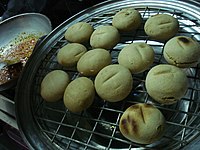Sattu (Hindi: सत्तू) is a type of flour, mainly used in Nepal, Tibet, Pakistan, and India. It consists of a mixture of roasted ground pulses and cereals. The dry powder is prepared in various ways as a principal or secondary ingredient of dishes. Sattu is used in vegetarian cuisine as it can be a source of protein.
In Bihar, it is Sattu is usually made from roasted kala chana or roasted maize. It is also common for people to mix Sattu of different Pulses together to suit their appetite and taste.
Etymology[edit]
The Punjabi, Urdu, Hindi and Bengali word Sattu[1] is derived from the Sanskrit word Saktu[2] meaning coarsely ground parched barley meal.[3] References to Sattu (Saktu) can be found throughout Ayurvedic literature such as the Caraka-saṃhitā, Aṣṭāṅgahṛdayasaṃhitā and the Suśruta-saṃhitā.[4]
History[edit]
The origin of Sattu is the Magadh region of Bihar. The process of preparing sattu is ancient[5] and it is popular over a wide area of Northern and Eastern India, particularly Bihar and its neighbouring states Uttar Pradesh, Jharkhand and East Bengal (now Bangladesh). Sattu is also famous in Telangana as prasadam or Nivedyam for Batukamma. There is a drink made from Sattu called "Sattu Ghol" in Magadh.

Uses[edit]

Sattu is used in regional cuisines in varying degrees. In Bihar, Uttar Pradesh, Uttrakhand, Punjab and Delhi the use of sattu is extensive in various dishes. In Bihar, it is commonly served cold as a savory drink during intense heat waves in summer or as a porridge or soft dough. Sweet dishes combine sattu with fruit slices, sugar and milk. In savoury dishes, sattu may be flavored with green chili, lemon juice and salt. It is a popular stuffing in parathas. In Bihar, sattu is prepared with toasted gram flour as well as toasted barley, or a mixture of both.
Sattu mixed with a little mustard oil and some spices is used as a stuffing in the traditional Bihari food litti and Litti Chokha (Dish).
In Punjab, it is used as a cold drink to mitigate heat and dehydration effects. It is a popular traditional summer drink in Pakistan’s Punjab region as well. The traditional way is to mix it with water and shakker (Punjabi) (Urdu) (Hindi) (jaggery). It is usually served cold. In Punjab, sattu is often a mix of toasted, ground barley.
In Odisha, it is a popular breakfast and is also called chhatua. Though there are many different ways to prepare chhatua, it is generally mixed with ripe bananas, cottage cheese (chenna), yogurt or milk.
Sattu made from ground barley can also be mixed with salt and turmeric and rolled into balls. Alternatively, millet and corn grains are also used.[5]
Ingredients[edit]
Sattu is prepared by dry-roasting grains or grams, most often barley or Bengal gram. In Odisha, Sattu or Chatua is made by dry-roasting cashew, almond, millet, barley and chickpea and grinding to a fine flour. The traditional way of preparing sattu involves the use of an iron vessel in which the grains or grams are roasted in sand. Afterwards, they are sieved and then ground into a fine flour.
Geography[edit]
In Pakistan, Sattu is common in the province of Panjab and Sindh. Sattu is common in the states of the Magadh Region of Bihar, Bihar and[6] Jharkhand and some other regions of India spread from Magadh like the Purvanchal Region of Uttar Pradesh, Madhya Pradesh, and Delhi.[5]
References[edit]
- ^ Dasa, Syamasundara (1965–1975). "Hindi sabdasagara". dsal.uchicago.edu. Retrieved 2022-12-29.
- ^ Turner, R. L. (Ralph Lilley) (1962–1966). "A Comparative Dictionary of Indo-Aryan Languages". dsal.uchicago.edu. Retrieved 2022-12-29.
- ^ "Monier-Williams Sanskrit-English Dictionary --स". sanskrit.inria.fr. Retrieved 2022-12-29.
- ^ www.wisdomlib.org (2016-03-18). "Saktu, Shaktu, Śaktu: 21 definitions". www.wisdomlib.org. Retrieved 2022-12-29.
- ^ a b c Harkesh Singh Kehal. Alop Ho Riha Punjabi Virsa. Pub. Lokgeet Parkashan. ISBN 81-7142-869-X.
- ^ Kumar Suresh Singh, Anthropological Survey of India (2008). People of India, Volume 16, Part 1. p. xxix. "However this term of opprobrium ignores the fact that the sattu is nutritious and has sustained the Bihari..."